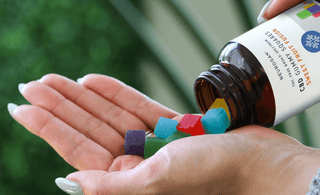As an alternative to smoking the hemp plant to receive the benefits of multiple cannabinoids, including CBD, many people enjoy eating it. If you're looking for something more palatable than CBD capsules or oils but are turned off by the price tag of some pre-made cookies, gummies, or brownies, this article is for you.
We'll take you through a step-by-step guide on taking whole hemp flower and infusing it into your baked good as an oil or butter. If you already have CBD drops on hand, we can eliminate some of the steps of preparing a cooking oil or butter and get straight to infusing your favorite dishes.
The Dos & Dont's Of Making CBD Edibles
Here are some of the quick tips for successfully making your own CBD edibles at home.
Do:
- Use high-quality, lab-tested hemp flower
- Decarboxylate your hemp flower to activate the cannabinoids
- Infuse your coconut oil, olive oil, or butter with hemp flower first
- Store your CBD cooking oil in a cool, dry place
Don't:
- Don't use marijuana flower straight in your cooking recipes
- Don't mix hemp flower directly into your CBD edibles
- Don't burn your CBD
- Don't forget to strain your homemade infused cannabutter/ oil properly
- Don't get lazy with mixing the CBD butter or oil into your recipe
Now that we've gone over the quick tips let's get into the essential step-by-step details
There are many different ways to make CBD edibles, but we'll guide you through the cannabutter/ coconut oil (vegan-friendly) method.

Overview: Steps to Making CBD Edibles
- Use High-Quality Hemp Flower
- Decarboxylate the Hemp
- Infuse with Cooking Oil
- Strain the Oil
- Storing your CBD-infused Oil & Butter
Step 1: Use High-Quality Hemp Flower
To make CBD edibles from scratch, you want to source high-quality hemp flowers and not marijuana flowers.
Hemp has a higher concentration of CBD, while marijuana contains high levels of THC that will get you stoned. Depending on your state, marijuana flowers for recreational use may also be illegal, so it's best to stick to 100% legal hemp flower.
When buying hemp flowers from an online retailer, always check to see that the brand provides a certificate of analysis from an independent lab that verifies the quality and safety of the flower.
The hemp plant is highly sensitive to its growing environment. If grown using pesticides in contaminated soil, traces of those contaminants can end up in the final product.
Step 2: Decarboxylate The Hemp
When working with unprocessed hemp buds, you'll need to decarboxylate the flower to activate the cannabinoids.
Decarboxylation is a fancy term for heating a substance to break a carbon chain in the molecules. This process takes the raw form of CBDa (cannabidiolic acid) into CBD, which is much more bioavailable.
To activate the hemp buds and feel the full set of effects, you don't want to skip this step as the raw flower doesn't contain high amounts of CBD.
How To Decarboxylate Hemp:
- Preheat your oven to 250 degrees F
- Lightly grind the buds or break them up into small pieces to create more surface area, but don't break it up too fine that it becomes difficult to strain later
- On a baking sheet, evenly spread out the flower
- Bake the hemp on the middle rack for 30–40 minutes—keep an eye on it to ensure you're not burning the flower. You may also want to mix up the buds on the baking sheet every 10 minutes to prevent burning
- Remove from oven and let it cool. It should look brown—but not burnt—and feel dry to touch and may easily crumble

Step 3: Infuse With Cooking Oil
Cannabinoids are lipophiles, which means it binds to fat and becomes more absorbable by the body or bioavailable. And since cooked hemp buds aren't the most appetizing flavor or texture in most dishes, infusing oil with CBD will make it easier to cook with.
Take your oil of choice—olive oil, coconut oil, or butter work best— in a saucepan or in a slow cooker and combine your decarboxylated cannabis flower on medium to low heat for around 15 minutes.
Keep a close eye on your oil as you don't want the oil or the flower to burn and cause a bitter taste in your CBD edibles or cook off the cannabinoids and terpenes.
What's The CBD To Cooking Oil Ratio?
A little bit of high-quality hemp goes a long way with edibles.
We recommend starting with a 1:1 ratio of decarboxylated flower to butter or oil. The fat in the oil can only bind with so many cannabinoids, so going past this ratio can be wasteful.
Step 4: Strain The Oil
Once your homemade CBD butter or oil has cooled, you'll need to strain it to remove the chunks of the flower. Use a cheesecloth and wear gloves, so you can squeeze out as much of the infused oil as possible from the hemp.
If you've ground your hemp too fine, it'll be difficult to separate it from the oil and it may make your cooking oil taste grassy.
Step 5: Storing Your CBD Drops/ Butter
Now that you've infused your cooking fat of choice with hemp flower, it's just a matter of storing it properly and cooking with it to get your daily dose of CBD in a tasty bite. Add a label with the ratio used and the date you've made it, so you know exactly what it is and how long to keep it.
If you've made cannabutter, you'll want to pour your infused butter into a block and store it in the fridge to harden. It'll keep for up to 3 months. You can do the same with coconut oil as it solidifies in cooler temperatures.
For CBD-infused olive oil, you can leave it on your counter, but store in a cool, dry place and use it within 3 weeks.

How to Cook With CBD-infused Oil
When you've made your own CBD-infused oil, it's difficult to get an accurate CBD dose, which is why you can expect to experiment with your oil.
If you're following a recipe, you don't want to go over the recommended amount of fat used as it can throw off the balance of the recipe.
The cannabutter is perfect in brownie recipes and cookies, while you can add CBD-infused olive oil to savory meals or even make your own CBD gummies. Make sure you're incorporating the CBD drops well into the recipe or one cookie could have significantly more CBD than the next. You can also use plant-based ingredients to enjoy vegan-friendly edibles if you have this dietary preference.
For more accurate doses—and if you don't want to fuss around with making your own CBD—you can purchase ready-made CBD in your desired potency and add them into your baking and cooking.
It's best to purchase ultra high-potency CBD for cost-effectiveness and so that you're not overpowering your edibles with too much oil. You'll pack a lot more CBD per mL of oil using a high potency CBD.
FAQs
What extract should you use to make edibles?
You can make homemade edibles using CBD drops or concentrate from the isolated CBD compound too. However, you'll be missing out on the benefits of minor cannabinoids such as CBG, CBN, and CBC along with naturally occurring terpenes, which are aromatic compounds that offer unique effects too.
Experts and experienced CBD users agree that full spectrum and broad spectrum CBD delivers more potent and well-balanced effects as minor cannabinoids can support the effects of CBD in the endocannabinoid system. Hemp buds are unprocessed and are naturally full spectrum, which means they may contain trace amounts of THC (up to 0.3%).
For a completely THC-free option, you can use broad spectrum extracts. This extract type has undergone extra processing to isolate and remove THC, but still maintain other beneficial cannabinoids.
What Are The Optimal Cooking Temperature For Making CBD Edible?
You don't want to go any hotter than 350 degrees F when cooking or baking with CBD-infused oil.
CBD can be baked or cooked and still keep most of its nutritional benefits, which is what makes it such a versatile compound. However, overheating your hemp buds or CBD drops can cause some of the terpenes and cannabinoids to break down and can leave your dish tasting bitter or burnt.
Recipe to Make Your Own CBD
It's fairly easy to make CBD edibles at home using high-quality hemp buds. It may take some time and experimentation to get right, but it's a rewarding process and it can save you money in the long run.
If you're not interested in making CBD-infused oils, then you can cook with CBD drops from your favorite brand—just make sure it's a high potency oil with at least 5000 MG of CBD per 1 oz containers.
For more ideas on how to get more CBD into your life to optimize your health and wellness, you can find more articles like this on our blog or get an Inside Scoop sent straight to your inbox.


